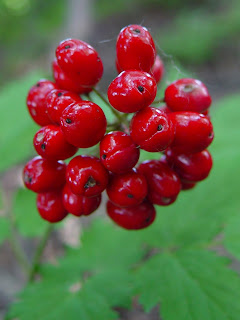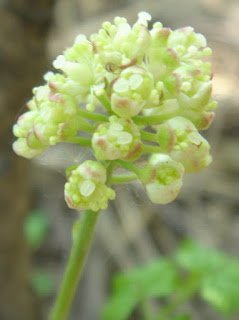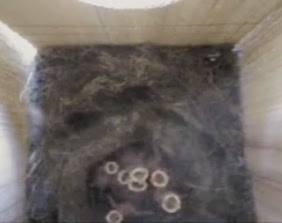Wandering in the woods, I came upon this rock. It has been there a long while and I've walked by it before. But today it looked more interesting with a pool of rainwater in the depression, reflecting the tree trunks above.
11/29/2016
10/24/2016
bird feeder garden
The veggie garden has been transitioned to a feeder garden for birds and pollinators. This year -- among the tomatoes, beans, peas, and squash -- I planted more native flowering plants. We watched as the nesting birds nearby brought their juveniles to the feeders and taught them how to feed themselves rather than gaping and begging. Now, with seed feeders and suet cages loaded, we'll start FeederWatch in a few weeks; we'll enjoy watching the birds that gather here and report our counts for ornithology research.
10/20/2016
chipmunks and sparrows
Stripes in the grass! The chipmunks Tamias striatus often hang out beneath the feeder tray. They can hide among the raspberry canes and safely dart out to gather seeds that the birds fling over the edge. The stripes on the chipmunks' backs give them away when they think they are being stealthy.
(They love tomato juice -- in the summer, they chew holes in my garden tomatoes and suck the juice.)
This week migrating White-throated Sparrows Zonotrichia albicollis joined the chipmunks gathering a meal, kicking among the grass to find each seed. Both species display stripes as part of their camouflage outfit.
(They love tomato juice -- in the summer, they chew holes in my garden tomatoes and suck the juice.)
This week migrating White-throated Sparrows Zonotrichia albicollis joined the chipmunks gathering a meal, kicking among the grass to find each seed. Both species display stripes as part of their camouflage outfit.
| Eastern Chipmunk |
| White-throated Sparrow |
10/18/2016
autumn harvest
| female Northern Cardinal Cardinalis cardinalis on birch |
The winter "guild" of feeder birds is forming. The adult birds in the wild wild woods have molted into their new feathers; their offspring juveniles have learned to fly and hunt on their own. As the leaves change color and insects are less abundant, birds instead harvest the ripe fruits and seeds on shrubs and trees.
10/08/2016
travel ready
The hummingbirds have been filling up on nectar for their migration south in coming days. This is the latest date I've seen Ruby-throated Hummingbirds still in Minnesota. But then, the climate has allowed flowers to bloom later than usual too.
9/10/2016
milkweed munchers
One leaf of Common Milkweed was being devoured by both a caterpillar and a beetle. I wonder if either knew the other was there?
8/20/2016
Indianpipe
 Indianpipe Monotropa uniflora is white because it contains no chlorophyll; it derives water and other nutrients by tapping into the thread-like
cells of the vegetative part of soilborne mycorrhizal fungi.
Indianpipe Monotropa uniflora is white because it contains no chlorophyll; it derives water and other nutrients by tapping into the thread-like
cells of the vegetative part of soilborne mycorrhizal fungi.It appears in forests, scattered, and uncommon. It will grow near a narrow range of mushrooms in the Russulaceae family. We saw this on a field sketching day in a nearby remnant of Big Woods.
Indianpipe is also called Ghost Plant or Corpse Plant.
7/30/2016
sunflowers
7/29/2016
resident Hummingbirds
7/02/2016
feathered nest
Tree Swallows Tachycineta bicolor, who line their nests with found feathers, fledged their five young out of the nestbox a few days ago. This is what I found when clearing out the box. I clean and save such feathers, then put them out again in Springtime for the next nesting season. Some birds place colored or shiny items in their nest . . . wire, yarn, ribbons, etc.
This collection included a little blue sparkly hair pin!
This collection included a little blue sparkly hair pin!
6/28/2016
baneberry
Red Baneberry, also known as Toadroot and
Chinaberry, grows in shady damp areas.
The white flowers grow in spikes that bloom during May in the wild wild
woods. Through the summer months,
Baneberry Actaea rubra ripens its fruits, which are egg-shaped berries, one-half inch long,
shiny, containing several seeds. In late summer, the berries turn bright red
with a black dot on them. The berries
are bitter and very poisonous, except to birds that disperse the seeds.

6/11/2016
Downy woodpeckers and squirrel
When the adult birds are away, a red squirrel comes by to see if he can peek in.
6/04/2016
Downy Woodpeckers feeding young
6/03/2016
Worms? Monsters?
Worms? Monsters? These are “finger galls”.
Insects or mites feeding on a leaf, or laying eggs on or injecting eggs into part
of a plant, cause galls to form. The leaf tissue reacts by increased production of normal plant
hormones and localized plant growth.
The outcome is an abnormal plant structure called a gall. These look like tiny wiggly "fingers" protruding from elm leaves.
Gall formation usually occurs in late spring during the
accelerated growth period of new leaves, shoots, and flowers. This is when insects might be feeding on plant tissue, or emerging in their life cycle to lay eggs. The gall-making insect develops inside the gall and the
gall continues to grow as the organism feeds and matures. In autumn and winter, some birds feast on
the insects they find inside galls, especially on goldenrod.
5/23/2016
peek inside a nest
A pair of Tree Swallows Tachycineta bicolor are nesting in one of several nest boxes near the wild wild woods. Today she laid the third egg. She is not yet incubating them, but keeps guard at the box opening all day.
5/22/2016
feeding baby birds
5/21/2016
furnishing a nestbox: House Wren
A House Wren Troglodytes aedon carries twigs, one at a time, to a nest box.
The male works until he fills the box with twigs, leaving a small cup or cavity.
The female adds soft grasses, fur, feathers, and junk to line the cup where she will lay her eggs.
Below, we peek inside another nest box containing a cozy nest for seven wren eggs.
The female will incubate the eggs for about 2 weeks.
5/20/2016
woods in bloom
top left: Arisaema triphyllum Jack-in-the-Pulpit; top middle: Geranium maculatum Wild Geranium; top right: Asarum canadense Wild Ginger; and a view of Aquilegia Columbine, all blooming now in the wild wild woods.
5/15/2016
nest cavity
A pair of Downy Woodpeckers decided the tree stump near the feeder garden is a good prospect for their 2016 nest cavity. They've been excavating into the old tree for a few weeks. Today, the female peeked out long enough for a look around; it was long enough for us to get a look at her!
5/14/2016
new hatchlings
Seven little Black-capped Chickadee eggs hatched in the last few days. The nestbox cam caught a snapshot when they were all gaping for food.
5/09/2016
4/30/2016
NestWatch
NestWatch, the citizen science project!
We look for cavity-nesting birds in trees as well as in nest boxes. A pair of Downy Woodpeckers has been excavating this hole overlooking the feeder gardens. Both will work at the nesting hole for up to three weeks. Their intent is to make a cozy cavity up to a foot deep in which to lay their eggs. They will line the bottom with woods chips. "Downies" usually lay 3 to 8 eggs; the eggs are white so the parents can see them in their dark cavity.
NestWatch

NestWatch!
Several nest boxes are in the yard and woods, waiting for cavity-nesting birds. Each box has a small video cam so we can watch the nest without disturbing the birds.
In this box a thick layer of moss was installed; then we saw grasses being laid in, re-arranged daily. The chickadee evidently laid her eggs over the past week, burying each one deep under the grass away from predators. Today, she started incubating them by gathering all seven and sitting close on them. A short flight outside revealed this treasure.
4/28/2016
Subscribe to:
Posts (Atom)























